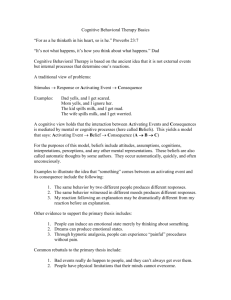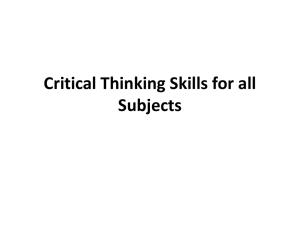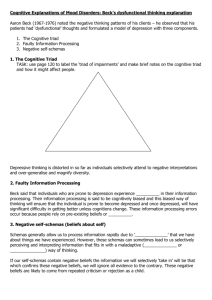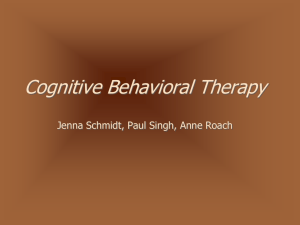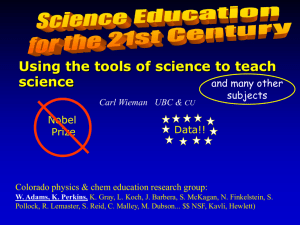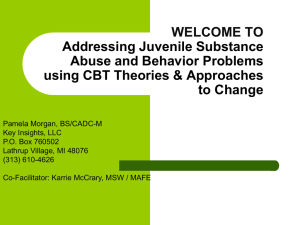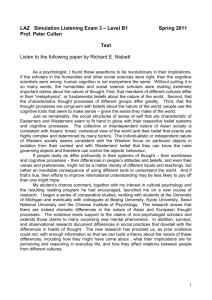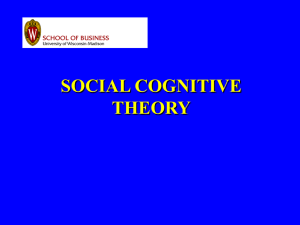Motivational-Theories-MASTER
advertisement
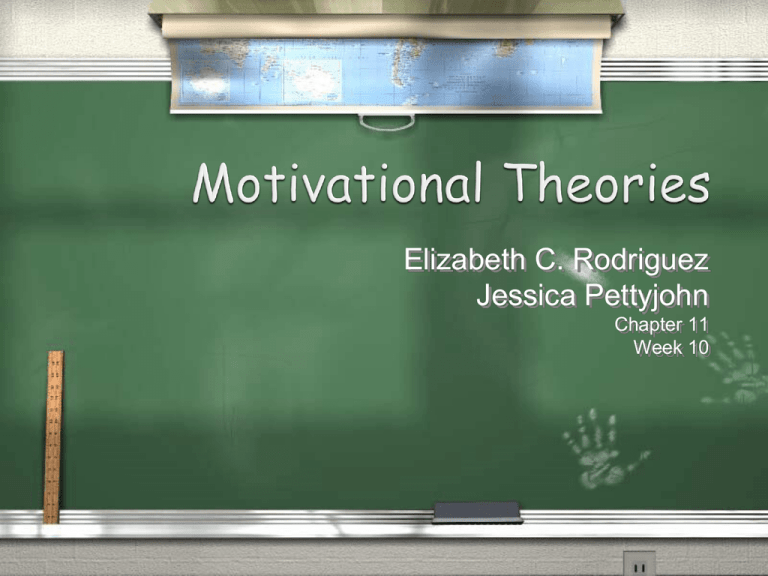
Elizabeth C. Rodriguez Jessica Pettyjohn Chapter 11 Week 10 What is Motivation? Motivation is the process of instigating and sustaining goal-directed behavior. Model of Motivated Learning The Model of Motivated Learning reflects a cognitive model because it views motivation arising largely from thoughts and beliefs. This model portrays three phases: Phase I: Pre-task Phase II: During Task Phase III: Post-task This is a convenient way to think about the changing role of motivation during learning. Model of Motivated Learning Example Historical Perspectives of Motivation 1. Drive Theory: was the motivational force that energized and prompted people into action 2. Conditioning Theory: explains motivation in terms of responses elicited by stimuli or emitted in the presence of stimuli 3. Cognitive Consistency Theory: assumes that motivation results from interactions of cognitions and behaviors 4. Humanistic Theory: as applied to learning is largely constructivist and emphasizes cognitive and affective processes. It addresses people’s capabilities and potentials as they make choices and seek control over their lives. Maslow’s Hierarchy of Needs This hierarchy helps teachers understand and create an environment to enhance learning. Achievement Motivation Achievement Motivation refers to striving to be competent in effortful activities (Elliot & Church, 1997) Examples of historical foundations of achievement motivation theory include: * Expectancy-Value Theory * Familiar Influences * Fear of Success Example of Model of Achievement Motivation Achievement Motivation Various factors in the social world affect the types of cognitive processes and motivational beliefs that students have. Social influences include factors associated with culture, the behaviors of important socialization influences in the person’s environment and past performance outcomes. Students’ initial motivational beliefs center on goals, task-specific self-concepts, and perceptions of task difficulty. Attribution Theory Weiner’s Model of Casual Attribution In his model, Weiner outlined the processes through which learners form causal beliefs (Weiner 1985, 2005). A basic assumption of Weiner's model of attributions is that learners are affected by both environmental factors (e.g., characteristics of the students' home or school) and by personal factors (e.g., prior experiences and prior knowledge). These background variables affect the types of attributions that individuals are likely to make. Social Cognitive Theory • • • • • • Important to pay attention to the link between motivation and learning Goals and expectations are learning mechanisms Goals and Expectations Goal setting and self-evaluation of goal progress Outcome expectations & self-efficacy Bandura (1986) reinforcement informs people about the likely outcomes of behaviors and motivates them to behave in ways they believe will result in positive consequences Social Comparison • • • • The process of comparing ourselves with others Positive effect on learning, increases self efficacy of others Developmental level is important – ability to use comparative information depends on cognitive level Social comparison changes with levels of development, especially in school environments Goal Theory o o o Goal theory states that important relations exist among goals, expectations, attributions, conceptions of ability, motivational orientations, social and self comparisons, and achievement behaviors (Ames, 1992) Different from goal setting theory – goal theory explains and predicts students’ achievement behaviors Goal orientation – refers to the purpose and focus of an individual’s engagement in achievement activities Goal Orientations • • • • • • Student’s reasons for engaging in academic tasks – a variety Learning goal is what knowledge, behavior, skill or strategy students are to acquire Learning goals focus students’ attention on processes and strategies that help them acquire capabilities and improve their skills Performance goal is what task students are to complete Performance goals focus attention on completing tasks There are emotional consequences of motivation in a school setting Conceptions of Ability • • • Two theories of intelligence: entity and incremental Entity theory is the belief that intelligence is relatively fixed, stable, and unchanging over time and with conditions (Difficulties = obstacles) Incremental theory roughly equates intelligence with learning, that intelligence can change and increase with experience, effort and learning (Difficulties = challenges) Implications for Teaching Perceptions of Control • • Perceived control over task engagement and outcomes is critical Control Beliefs – • • • Strategy Beliefs Capacity Beliefs Control Beliefs Learned Helplessness • A psychological state involving a disturbance in motivation, cognitive processes, and emotions because of previously experienced uncontrollability Students with Learning Problems • • • • • Learned helplessness is experienced by many students with learning problems Lower expectations, judge themselves lower in ability & emphasize lack of ability Females may be more helpless orientated Reading deficiencies make problems worse Teachers can help these students! Self Concept Refers to one’s collective self- perceptions: • Formed through experiences with and interpretations of the environment and • Heavily influenced by reinforcements and evaluations by significant other person Important multidimensional parts: Self-Esteem, Self-Confidence, Self-Concept Stability, Self-Crystallization Four Sources of Intrinsic Motivation 1. Challenge 2. Curiosity 3. Control 4. Fantasy Intrinsic Motivation vs. Extrinsic Motivation Motivation & Self-Regulation Volition – the act of using the will for one’s wants Values – students opinion of learning Self-Schemas – cognitive manifestations of goals, aspirations, fears and threats Help Seeking – self-regulation fosters asking for help Summary & Questions
